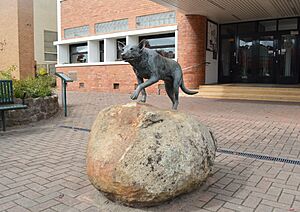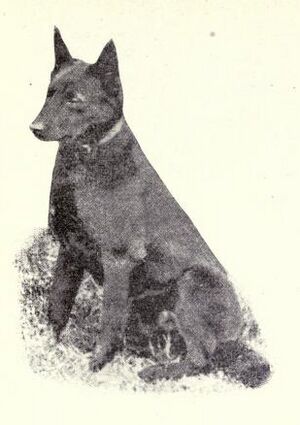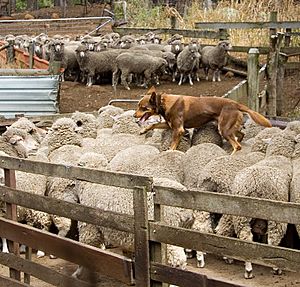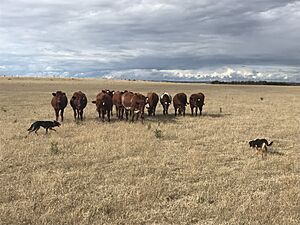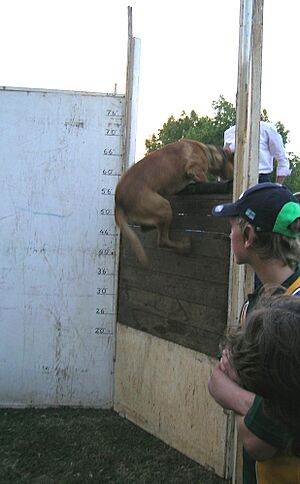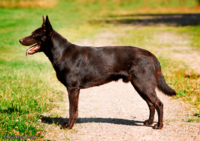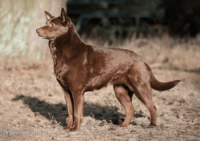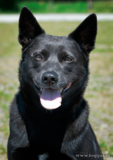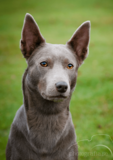Australian Kelpie facts for kids

An Australian Kelpie
|
|||||||||||||||||||||
| Other names | Kelpie, Barb | ||||||||||||||||||||
|---|---|---|---|---|---|---|---|---|---|---|---|---|---|---|---|---|---|---|---|---|---|
| Common nicknames | Farmer Dog | ||||||||||||||||||||
| Origin | Australia | ||||||||||||||||||||
|
|||||||||||||||||||||
|
|||||||||||||||||||||
| Domestic dog (Canis lupus familiaris) | |||||||||||||||||||||
The Australian Kelpie, often just called a Kelpie, is a super smart Australian sheepdog. These medium-sized dogs are amazing at gathering and moving livestock like sheep, cattle, and goats. They can do this with very little help from people! Kelpies come in many different colors and are popular all over the world for their working skills.
There are two main types of Kelpies. The "Show Kelpie" is bred for its looks and often seen in dog shows. The "Working Kelpie" is bred for its incredible ability to herd animals. Both types are wonderful dogs, but they have different focuses.
Discovering the Australian Kelpie
A Look Back: Kelpie History
The ancestors of most Kelpies were British dogs called collies. These dogs were usually black or very dark brown. They were brought to Australia in the early 1800s to help farmers with their sheep. These early collies were bred with other dogs to create a breed that could work sheep without constant supervision.
For a long time, some people thought Kelpies might have had dingo ancestors. They believed this made the dogs extra tough and hardy. However, recent studies looking at specific genes for things like ear shape and coat color didn't find a direct link to dingoes for those features. Scientists clarified that this research didn't look at the breed's entire genetic history. So, it doesn't completely rule out any dingo connection in the past.
The First Kelpies and Their Names
The very first dog called "Kelpie" was a black and tan female puppy. She was bought around 1872 by Jack Gleeson. This dog was named after a kelpie, a magical shapeshifting water spirit from old Celtic stories. Later, her daughter was also called Kelpie, so people started calling the original dog "(Gleeson's) Kelpie."
Another important Kelpie was "(King's) Kelpie," the daughter of the first Kelpie. She was also black and tan. This dog did very well in a famous sheepdog competition in 1879. Soon, dogs from this family became known as "Kelpie's pups," or simply "Kelpies."
Later, a black Kelpie puppy was named "Barb" after The Barb, a famous black racehorse. This horse won the Melbourne Cup in 1866. Because of this, black Kelpies are sometimes called Barb Kelpies or Barbs.
Many Kelpies have become famous. One notable Kelpie was Red Dog, who lived from about 1971 to 1979. He was a Kelpie mix and even had a movie made about him in 2011! Kelpies have traveled to many countries, including Canada, New Zealand, and the United States. They are used for many jobs, even as scent dogs for tracking and rescue missions.
What Does a Kelpie Look Like?
Kelpies are medium-sized dogs with soft coats. They usually have pointy ears and look very athletic. They typically weigh between 14–20 kg (31–44 lb) and stand about 41–51 cm (16–20 in) tall at the withers (the highest part of their back, between the shoulder blades). Their coats come in many colors, including black, red, blue, fawn, and various combinations with tan.
Different Types: Working vs. Show Kelpies
The first official description of the Kelpie breed was written in 1904. Today, how a Kelpie is described depends on if it's a working dog or a show dog. It's possible for a Kelpie to do both, but rules can vary.
In Australia, there are two main groups that register Kelpies. The Working Kelpie Council (WKC) focuses on breeding dogs for their working ability. They allow many different coat colors. The Australian National Kennel Council (ANKC) registers Show Kelpies. This group focuses on a specific appearance and has fewer acceptable colors. Many Working Kelpies don't meet the strict appearance rules for show competitions.
In the United States, the American Kennel Club (AKC) now accepts Australian Kelpies. They can compete in AKC-approved sheep herding trials. Other groups like the United Kennel Club and the Canadian Kennel Club also recognize the breed.
The Amazing Working Kelpie
Working Kelpies have short, smooth, or rough coats. Their coats can be almost any color, from black to light tan or cream. Some might have a white patch on their chest. They can range in size from about 19–25 in (48–64 cm) tall and 28–60 lb (13–27 kg) in weight.
A good Working Kelpie is like having several helpers on a farm! They are amazing at herding all kinds of animals, including sheep, cattle, goats, and even poultry. They have a natural instinct to keep animals from wandering away. One of their special moves is to jump on the backs of sheep to get to the other side of a crowded pen and break up a jam. Working Kelpies often compete in trials to show off their herding skills.
The Popular Show Kelpie
Show Kelpies registered with the ANKC come in specific colors: Black, Chocolate, Red, Smoky Blue, Fawn, Black and Tan, and Red and Tan. They have a double coat and pointy ears. Other colors can be registered as pets or for dog sports. Show Kelpies first appeared in shows in the early 1900s. Today, they are very popular as family pets, companions, and sport dogs. This is because they are easy to train, have a good nature, and don't need a lot of special care.
Kelpie Personality and Care
Kelpies are very intelligent dogs and are usually easy to train. This makes them good-tempered and wonderful pets, especially with children. However, they need a lot of physical exercise and mental challenges. If they get bored, they might start barking a lot, digging, or chewing on things. Working Kelpies are often called "workaholics" because they have such a strong desire to herd and be busy!
Keeping Kelpies Healthy
Kelpies are generally a very strong and healthy breed. They don't have many health problems. However, like all dog breeds, they can sometimes get certain conditions. These include cryptorchidism (a condition affecting male dogs), hip dysplasia (a hip joint issue), and luxating patella (a knee cap issue). Scientists are also studying a condition called cerebellar abiotrophy in the breed.
A study in the UK in 2024 looked at the life expectancy of Kelpies. It found that Kelpies lived for about 12 years on average. This is similar to the average lifespan for many other purebred and mixed-breed dogs.
Notable Kelpies
A Kelpie named Maggie, who lived with a dairy farmer in Victoria, Australia, was once believed to be the world's oldest dog. She lived to be an amazing 30 years old!
Show coat colours
See also
 In Spanish: Kelpie australiano para niños
In Spanish: Kelpie australiano para niños
- Australian Cattle Dog
- Australian Shepherd
- Australian Stumpy Tail Cattle Dog
- Koolie
- List of dog breeds
- Sheep husbandry
- Working Group (dogs)


